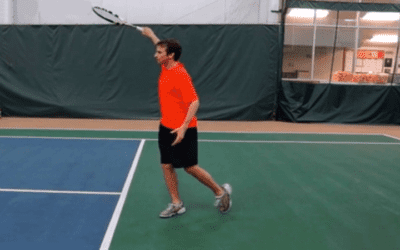Tennis Forehand Tips I How To Attack Short Balls
Are you struggling to attack short balls accurately with power? In this article, I’ll share four amazing tennis forehand tips to help you master this shot. Besides, I’ll also explain in great detail how you can practice them on the court. This is a common shot that frustrates many tennis players when they’re facing a pusher. Therefore, I encourage you to work on these forehand tennis tips consistently to level up your game faster.
Let’s get started.
Aggressive Mindset

Players that don’t hit the ball very hard and play passively are popularly called “Pushers”. They want you to try to fall prey to their game, so don’t get caught in this trap. One of the keys for generating your own pace is to have an aggressive mindset.
When preparing to play a point, commit to the process of attacking any a short ball that lands around the service line. If your opponent’s ball doesn’t seem to have any pace and feels wimpy, keep in mind the following tips. Don’t back off on the power, technique and mental focus required to hit a high quality shot. Take the opportunity to be aggressive and seize it.
Forehand Swing Path

You can start punishing short balls by focusing on having the correct swing path on the shot. When you get a ball that bounces high and out of your strike zone, you still need to adjust your swing path and swing more across your body. Many players prefer to swing down to the pocket (High To Low Type Swing) instead of low to high. You want to set the racquet higher when the ball gets up out of your strike zone. Then, you can swing across and down aggressively.
These same tennis tips also apply to instantly fix your high forehand and help you to master it from any part of the court. In fact, it is easier to get more racquet head acceleration when you do this. Moreover, you’ll be able to generate pace while still being able to bring the ball down into the court.
When approaching short balls, you should use the correct footwork to get in a good position and hit powerful shots. Players who like to stay on the baseline have problems attacking short balls. This issue derives from not moving up into the court and getting in a comfortable position.
This hesitation makes you late to the ball and you simply can’t attack. When the ball lands short and is within your strike zone, use the lift and land footwork pattern. As the ball approaches, get on the front foot and hop slightly off the court as you make contact. Thus, you can use that momentum to propel yourself forward in order to come to the net.
When you get a higher bouncing short ball, you should handle it differently and load the outside leg. Then, you can jump in the air as you hit the ball, and land on the front foot. Afterwards, you can come forward to the net to finish the point. This footwork pattern will keep you stable on higher balls and allow you to attack them.
Tennis Forehand Tips: Clear Targets

When trying to crush a short ball with no pace, try aiming low over the net and just past the service line. This kind of target will help you keep from spraying the balls long.
Use the above tennis forehand tips to boost your confidence when hitting slower paced balls around the service line. Once you get comfortable punishing those sitters, you’ll start winning more matches against passive players and so called “Pushers”.
By Jeff Salzenstein, Founder Tennis Evolution
Jeff is a former top 100 ATP player and USTA high performance coach committed to helping players and coaches all over the world improve.
P.S. – Ready to take it to the next level with your tennis? Click here to get a free tennis course inside the Tennis Evolution App. Learn the exact step-by-step system that has transformed the games of thousands of players worldwide.




0 Comments